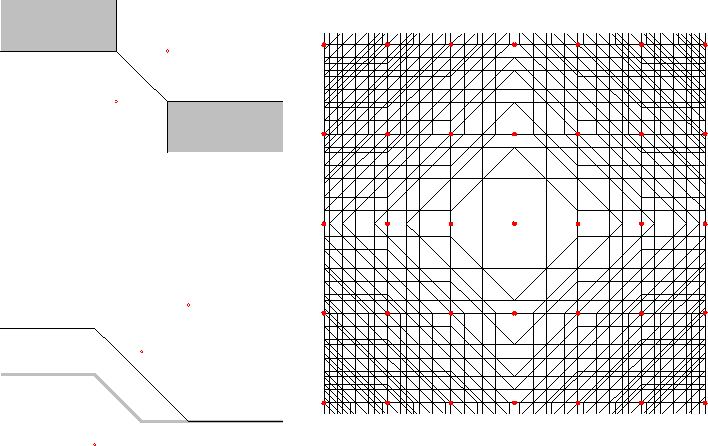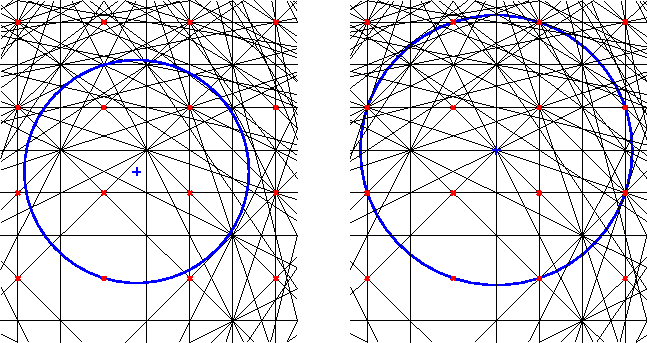Notation: Throughout this paper, we shall assume X is a path connected, proper (see below) metric space (with metric
In this section, we prove that under very general conditions, Brillouin zones tile (as defined below) the space in which they are defined, generalizing an old result of Bieberbach [Bi]. With stronger assumptions, we prove that these tiles are in fact well-behaved sets: they are equal to the closure of their interior.
Notation:
Throughout this paper, we shall assume X is a path connected, proper (see
below) metric space (with metric
![]() ).
We will make use the following notation:
).
We will make use the following notation:
Note if X is proper, it is locally compact and complete. The converse also holds if X is a geodesic metric space (see Thm. 1.10 of [Gr]). The metric spaces considered here need not be geodesic.
Note that any mediatrix La,b separates X, that is: X-Labcontains at least two components (one containing the point a and the other b).
Let L0a be a mediatrix. If it is minimally separating, then X-L has
exactly two components. Also note that if a separating set
![]() contains a non-empty open set V, it cannot be minimally
separating. For if A and B are disjoint open sets containing
X-L, then so are
contains a non-empty open set V, it cannot be minimally
separating. For if A and B are disjoint open sets containing
X-L, then so are
![]() and
and
![]() .
Now let x be any point in V. Then
it is easy to see that the disjoint open sets
.
Now let x be any point in V. Then
it is easy to see that the disjoint open sets
![]() and
and
![]() cover X-(L-x). Thus L-x separates.
cover X-(L-x). Thus L-x separates.
We define the following sets
Usually, there will be a discrete set of points
The last two conditions in the above definition may be weakened to apply only to those mediatrices Lab where a and b in S. In this case, we will say that X is Brillouin over S, if it is not obvious from the context.
 |
As mentioned in the introduction, for each ![]() ,
the
mediatrices Lx0 a give a partition of X. Informally, those elements of
the partition which are reached by crossing n-1 mediatrices
from x0 form the n-th Brillouin zone, Bn(x0). This definition is
impractical, in part because a path may cross several mediatrices
simultaneously, or the same mediatrix more than once. Instead, we will use
a definition given in terms of the number of elements of S which are
nearest to x.
This definition is equivalent to the informal one
when X is Brillouin over S (see Prop. 2.13 below).
We use the notation
,
the
mediatrices Lx0 a give a partition of X. Informally, those elements of
the partition which are reached by crossing n-1 mediatrices
from x0 form the n-th Brillouin zone, Bn(x0). This definition is
impractical, in part because a path may cross several mediatrices
simultaneously, or the same mediatrix more than once. Instead, we will use
a definition given in terms of the number of elements of S which are
nearest to x.
This definition is equivalent to the informal one
when X is Brillouin over S (see Prop. 2.13 below).
We use the notation ![]() to denote the cardinality of the set S.
to denote the cardinality of the set S.
 |
The following lemma, which follows immediately from Def. 2.7, explains a basic feature of the zones, namely that they are concentric in in a weak sense. This property is also apparent from the figures.
The Brillouin zones actually form a covering of X by
non-overlapping closed sets in various ways. This is proved
in parts. The next two results assert that the zones B cover
X, but the zones b do not. The first of these is an immediate
consequence of the definitions. The second is more surprising and leads
to corollary 3.4. The fact that the Bi(xn)
is the closure of bi(xn) (and thus that the interiors do
not overlap) is proved in proposition 2.12. We
will use the word ``tiling'' for a covering by non-overlapping
closed sets.
 |
Proof:
First, we show that for any fixed n>0 and each ![]() ,
there is an
,
there is an ![]() with
with
![]() .
Re-index S so that if
.
Re-index S so that if
![]() and
i < j, then
and
i < j, then
![]() .
This can be done; since S is a discrete subset and closed
balls Dc(xi) are compact,
the subsets of S with
.
This can be done; since S is a discrete subset and closed
balls Dc(xi) are compact,
the subsets of S with
![]() are all
finite. Let
ri = d(x,xi). We will show that
are all
finite. Let
ri = d(x,xi). We will show that
![]() .
.
Note that
![]() .
Suppose first that
rn > rn-1, then
.
Suppose first that
rn > rn-1, then
![]() contains exactly n-1 points, and
contains exactly n-1 points, and
![]() .
Thus
.
Thus
![]() .
Note that if
rn+1 > rn, then we
would have
.
Note that if
rn+1 > rn, then we
would have
![]() .
.
If, on the other hand,
rn = rn-1,
then there is a k>0 so that
![]() ,
and so
,
and so
![]() .
But then
.
But then
![]() ,
and hence
,
and hence
![]() as desired.
as desired.
For the second part, we show that
![]() .
If not, then there is a point x in their intersection.
If ri = rj, then xi = xj, because by the definition of
bn(xk),
.
If not, then there is a point x in their intersection.
If ri = rj, then xi = xj, because by the definition of
bn(xk),
![]() .
If not, then
ri < rj. In this case,
.
If not, then
ri < rj. In this case,
![]() . Thus, since
. Thus, since
![]() ,
Nrj(x) must
contain at least n points of S, a contradiction.
,
Nrj(x) must
contain at least n points of S, a contradiction.
![]()